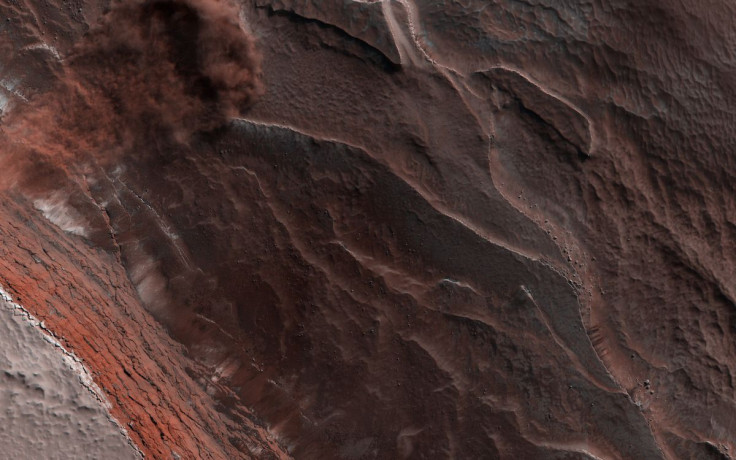NASA Mars Orbiter Captures Stunning Avalanche On Red Planet As Ice, Blocks Destabilize

NASA’s Mars Reconnaissance Orbiter has captured an incredible image of an avalanche on the Red Planet. According to NASA, avalanches on Mars regularly occur during springtime.
The photo of the avalanche was captured by the orbiter through its onboard High Resolution Imaging Science Experiment (HiRISE) camera, which was developed by the Lunar and Planetary Laboratory of the University of Arizona. In the image, a cloud of reddish dust can be seen on the side of a mountain on Mars.
As explained by the experts, avalanches on the alien planet usually occur during spring when the warmth from sunlight causes the ice layers to melt and crumble.
“Every spring the Sun shines on the side of the stack of layers at the north pole of Mars known as the north polar layered deposits,” Candy Hansen of the University of Arizona’s Lunar & Planetary Laboratory wrote.
“The warmth destabilizes the ice and blocks break loose,” she added.
Avalanche season on Mars: Every spring the Sun shines on the layered deposits near the planet’s north pole, destabilizing the ice there. In May, our Mars Reconnaissance Orbiter caught this avalanche in the act. Details: https://t.co/tFov7f45E7 pic.twitter.com/b8RA3fEe3I
— Cassini (@CassiniSaturn) September 3, 2019
According to Hansen, the cloud from the avalanche is produced once the loosened layers of debris reach the bottom of the Martian cliff. Since the layers at the bottom of the mountain are composed of different materials with varying textures and colors, clouds with an unusual appearance are formed by the avalanche.
“When the reach the bottom of the more than 500-meter-tall cliff face, the blocks kick up a cloud of dust,” Hansen wrote. “The layers beneath are different colors and textures depending on the amount of dust mixed with ice.”
Aside from the warm season, avalanches on Mars can also be caused by a number of things on its surface. In June 2018, NASA’s orbiter was able to spot an avalanche that was caused by a meteoroid impact on Mars.
According to NASA, the rock that hit the Martian surface was only about five meters long and left a small crater. Since the meteoroid crashed on a slope, it destabilized it and caused an avalanche of dirt and dust.
In the image captured by the Mars Reconnaissance Orbiter’s HiRISE camera, the trail of the avalanche, which formed a long streak on the surface, can be seen originating from the impact crater.
© Copyright IBTimes 2024. All rights reserved.





















